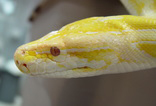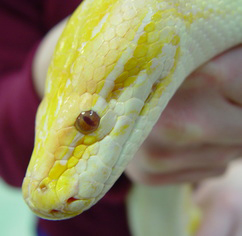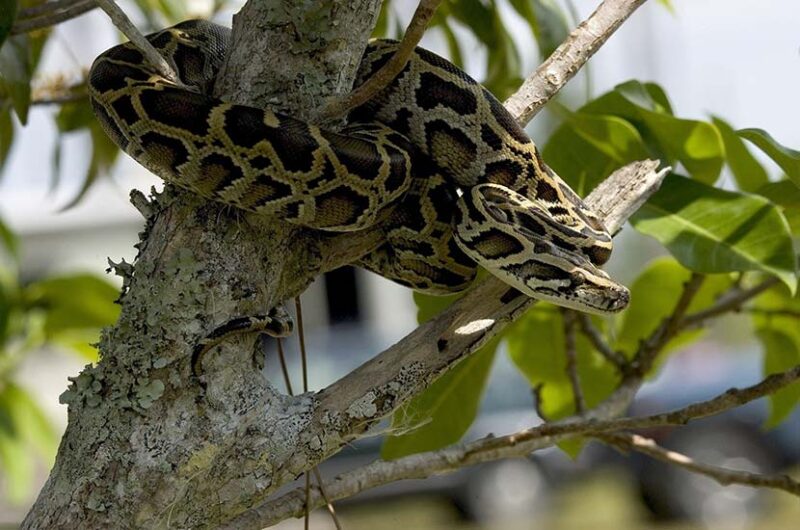Erica Mede, CVT
Photos and edited by Susan Horton, DVM
 Burmese pythons have become one of the most popular large snakes kept in captivity due to their impressive size and excellent temperament. With daily handling, Burmese python (also called, Burms or Burmese Rock pythons) hatchling and juveniles can be transformed from defensive nippy snakes into calm pets. However, the power of this species should never be underestimated! These snakes are large in maturity and can cause severe injury if not properly handled and respected. Burms, although well tempered, are given up frequently due to their massive size and food requirements. This is at least a 20 year commitment and a hefty financial investment as well.
Burmese pythons have become one of the most popular large snakes kept in captivity due to their impressive size and excellent temperament. With daily handling, Burmese python (also called, Burms or Burmese Rock pythons) hatchling and juveniles can be transformed from defensive nippy snakes into calm pets. However, the power of this species should never be underestimated! These snakes are large in maturity and can cause severe injury if not properly handled and respected. Burms, although well tempered, are given up frequently due to their massive size and food requirements. This is at least a 20 year commitment and a hefty financial investment as well.
Natural History
 Burmese pythons are diurnal, rainforest dwelling snakes that are excellent climbers, especially when they are still young, and they are swimmers. These snakes are indigenous to south-east Asia from India to southern China includingBurma, Thailand, Vietnam, and Indonesia. Currently, Burmese pythons have been classified as Endangered by IUCN and Threatened Appendix II of CITES. Captive breeding has become a successful and even lucrative business in the United States as well as Europe especially for collectors seeking different morphs or color variations.
Burmese pythons are diurnal, rainforest dwelling snakes that are excellent climbers, especially when they are still young, and they are swimmers. These snakes are indigenous to south-east Asia from India to southern China includingBurma, Thailand, Vietnam, and Indonesia. Currently, Burmese pythons have been classified as Endangered by IUCN and Threatened Appendix II of CITES. Captive breeding has become a successful and even lucrative business in the United States as well as Europe especially for collectors seeking different morphs or color variations.
Description
Generally, these snakes will grow up to 17-18 feet in length and 200 pounds or more. The average lifespan is 15-20 years in captivity sometimes living until 25 years of age. Their heavy body has a net like pattern on the back with solid colored belly scales. Depending on what morph you have the colors will vary. However, a normal Burmese python will have tan or dark brown outlined in yellow and black markings with a white or cream colored underside. These pythons, like all pythons and boas (boids) have heat sensing pits on what would be considered their upper lip for tracking and identifying prey.
Sexing
 Typically, the female of the species is larger than the male. Females generally reach 17-20 feet in length while males reach 10-15 feet in length. The males however, have longer spurs (vestigial remnants of hind limbs on either side of the cloaca or vent) than the females do. Pictured to the left is a male. A Chicago Exotics’ veterinarian can sex the snake as well using a probe. It is not recommended for inexperienced keepers to probe their own snakes as severe damage can be caused to the genitalia of the snake.
Typically, the female of the species is larger than the male. Females generally reach 17-20 feet in length while males reach 10-15 feet in length. The males however, have longer spurs (vestigial remnants of hind limbs on either side of the cloaca or vent) than the females do. Pictured to the left is a male. A Chicago Exotics’ veterinarian can sex the snake as well using a probe. It is not recommended for inexperienced keepers to probe their own snakes as severe damage can be caused to the genitalia of the snake.
Enclosures
A hatchling (around 22” long) can be housed in a 55-gallon aquarium comfortably. These snakes grow exceedingly quickly and it is recommended to use the largest size possible when housing them. A hatchling housed in a 20-gallon aquarium will quickly out grow it within 1-2 months! As Burms grow larger they will require larger accommodations. Many keepers build their own custom enclosures from wood, glass, and Plexi glass. There are also companies that offer to build custom enclosures for a nominal fee. Chicago Exotics’ recommends the use of Cages by Design for your large cage requirements. Other keepers have converted sections of rooms into enclosures to accommodate their pets. A 200 pound snake is going to require an enclosure at least 4 feet by 8 feet wide. The height of the enclosure is not as important as the floor space. When in doubt, go wider rather than taller.
The most important aspect of any enclosure is safety. Always make sure that the enclosure is both escape proof and child resistant.
Small vents can be placed on the side of enclosures or a portion of the screened top can be covered to allow the humidity to remain around 50-60%. Humidity is important to the hydration level of the snake as well as the skin’s condition and is especially important while shedding.
A photoperiod (light cycle) of 10-12 hours of light with 10-12 hours of darkness is essential to normal behavior and the overall health of the animal. A snake with the lights always left on will become overly stressed and possibly fall ill or experience temperament changes.
The day time ambient (temperature of the air) temperature should be around 85-88 degrees Fahrenheit on the warm end, and 80-84 degrees on the cool side of the enclosure. A basking area should be provided and should be around 90-93 degrees. At night temperatures should not fall below 75 degrees to maintain proper digestive activity. At least two thermometers should be installed in the enclosure one inch above the floor on both the cool end and the warm end of the cage. It is recommended to also have a third thermometer above the basking area.
Fresh, clean water should be offered daily to Burms and ideally will be large enough for the snake to soak. Of course as these snakes grow it may become necessary to find more creative methods of soaking them including using a bath tub in a secure bathroom. If a bathtub is used, disinfect the tub after use with a 10% bleach solution and rinse thoroughly and allow the tube to dry before human use.
Substrates are best kept simple as these snakes can be messy. Daily spot cleaning and monthly whole enclosure cleanings are made easier when the décor is kept to the basics. Newspaper is an old favorite of many reptile keepers as it is both cheap and easy to clean. However, it is not very absorbent and may need to be layered thickly. Towels are not recommended unless advised by your veterinarian. Chicago Exotics’ does not suggest you use any form of bark product as some contain harmful oils (cedar and pine) while others retain water and can lead to the growth of harmful mold and bacteria (fir and aspen).
If a bark product must be used, aspen changed at least once a week is the best choice. Reptile carpet substrate of choice for typical enclosures as it is easily washed and replaced. Keepers of large specimens and custom enclosures sometimes use linoleum on the floor and up a portion of the sides of the enclosure as it is easy to clean. Remember, all enclosures must be dry before placing returning the snake to it.
A hide box is essential for providing added humidity and security for this species. A half log, card board box, commercial hide box, or an upside down plastic container that the snake cannot see through are all good choices. Larger animals will require more creative hide boxes including litter pans, garbage cans, or custom made ones.
Common Medical Problems
 Good husbandry is the best way to prevent many problems. Burmese pythons should be quarantined for at least three to six months before being added to an established collection.
Good husbandry is the best way to prevent many problems. Burmese pythons should be quarantined for at least three to six months before being added to an established collection.
IBD (Inclusion Body Disease) affects boas and pythons and is fatal to Burms. This disease can take several months to manifest and does not require snake-to-snake contact to transmit. Loss of appetite, regurgitation, infection, contorted body position, and star-gazing (the snake stretches up and appears to be admiring the ceiling) should be reported to your Chicago Exotics’ veterinarian immediately!
Respiratory tract disease, such as pneumonia, is very common in captive snakes. Difficulty breathing, discharge from the mouth, and wheezing are common signs associated with respiratory tract disease.
Vomiting/Regurgitating are common signs of many problems. Inadequate temperature, excessive feeding, and handling after feeding are common causes. There are many medical causes for vomiting/regurgitation and an appointment with Chicago Exotics’ should be made.
Snake Mites are very common external parasites. The mites can cause significant disease and distress to a snake and can be transferred to other snakes in the collection.
Internal parasites can be tested for with a fecal reading by a Chicago Exotics’ veterinary professional. This is recommended at least yearly.
Other common signs of problems include loss of appetite, loose stools, difficulty shedding, and lumps/bumps. Please make an appointment with your veterinarian to diagnose and treat any of these problems.
Speak with your Chicago Exotics’ veterinarian or technician about Salmonella and what measures are recommended to limit the risk or transmission to people.
Sources and Suggested Reading
The General Care and Maintenance of Burmese Pythons, Philippe de Vosjoli (1990)
The Snake: An Owner’s Guide to a Happy Healthy Pet, Lenny Flank
Burmese Pythons, John Coburn (1994)
Snakes of the World, Scott Weidensaul (1991)
Burmese Python – www.anapsid.org
NERD Herpetocultural Library – www.newenglandreptile.com
Burmese Python Care by Chris M. Jones – www.ezinearticles.com
The Burmese Python: Making it a Home in your Home from Reptiles Magazine, Bob Clark
If you have any questions, please feel free to call us at (502) 241-4117.
Special thanks to Dustin Dorgan, CVT for allowing us to photograph his beautiful albino burm!


